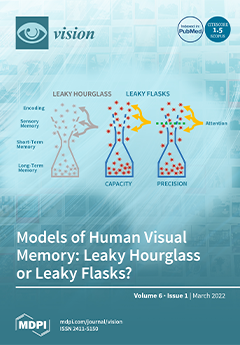This study aimed to assess the anterior corneal wavefront aberrations, keratometry, astigmatism vectors and pupil size between Pentacam HR
® (Oculus Optikgeraete GmbH, Wetzlar, Germany) and iTrace
® (Tracey Technologies Corp., Houston, TX, USA). In this observational study, 100 eyes (50 healthy volunteers)
[...] Read more.
This study aimed to assess the anterior corneal wavefront aberrations, keratometry, astigmatism vectors and pupil size between Pentacam HR
® (Oculus Optikgeraete GmbH, Wetzlar, Germany) and iTrace
® (Tracey Technologies Corp., Houston, TX, USA). In this observational study, 100 eyes (50 healthy volunteers) were scanned in mesopic light condition with a Pentacam HR
® and iTrace
®. Anterior corneal aberrations (spherical aberration (Z40), vertical coma (Z3 − 1), horizontal coma (Z3 + 1)), keratometry in the flattest (K1) and steepest meridian (K2), mean astigmatism, astigmatic vectors (J0 and J45), and pupil size were measured. We found a significant difference in Z40 (Pentacam
®: +0.30 ± 0.11 µm and iTrace
®: −0.03 µm ± 0.05 µm;
p < 0.01) with no correlation between the devices (r = −0.12,
p = 0.22). The devices were in complete agreement for Z3 − 1 (
p = 0.78) and Z3 + 1 (
p = 0.39), with significant correlation between the machines (r = −0.38,
p < 0.01 and r = −0.6,
p < 0.01). There was no difference in K1, K2 and mean astigmatism. J0 was negative with both devices (against-the-rule astigmatism), but there was no correlation. J45 was negative with the Pentacam HR
® (more myopic oblique astigmatism) but significantly correlated between the devices. Pupil size was smaller with Pentacam HR
® (
p < 0.01). In summary, these devices cannot be used interchangeably. Corneal Z40 was significantly different with more negative Z40 with iTrace
® compared to Pentacam HR
®. iTrace
® operates with lower illumination, giving larger pupil size than Pentacam HR
®, which uses intense blue light during measurement. No correlation was found for J0. Pentacam HR
® had a trend to record more negative J45 (myopic oblique astigmatism).
Full article






